A recently published abstract for an upcoming chapter about Early Slavs shows the generalized view among modern researchers that Common Slavs did not spread explosively from the east, an idea proper of 19th-century Romantic views about ancestral tribes of pure peoples showing continuity since time immemorial.
Migrations and language shifts as components of the Slavic spread, by Lindstedt and Salmela, In: Language contact and the early Slavs, Eds. Tomáš Klír, Vít Boček, Universitätsverlag Winter (2019):
The rapid spread of the Proto-Slavic language in the second half of the first millennium CE was long explained by the migration of its speakers out of their small primary habitat in all directions. Starting from the 1980s, alternative theories have been proposed that present language shift as the main scenario of the Slavic spread, emphasizing the presumed role of Slavic as the lingua franca of the Avar Khaganate. Both the migration and the language shift scenarios in their extreme forms suffer from factual and chronological inaccuracy. On the basis of some key facts about human population genetics (the relatively recent common ancestry of the East European populations), palaeoclimatology (the Late Antique Little Ice Age from 536 to around 660 CE), and historical epidemiology (the Justinianic Plague), we propose a scenario that includes a primary rapid demographic spread of the Slavs followed by population mixing and language shifts to and from Slavic in different regions of Europe. There was no single reason for the Slavic spread that would apply to all of the area that became Slavic-speaking. The northern West Slavic area, the East Slavic area, and the Avar sphere and South-Eastern Europe exhibit different kinds of spread: mainly migration to a sparsely populated area in the northwest, migration and language shift in the east, and a more complicated scenario in the southeast. The remarkable homogeneity of Slavic up to the jer shift was not attributable to a lingua-franca function in a great area, as is often surmised. It was a founder effect: Proto-Slavic was originally a small Baltic dialect with little internal variation, and it took time for the individual Slavic languages to develop in different directions.
While I would need to read the whole chapter, in principle it seems easier to agree with this summary than with Curta’s (sort of diffuse) Danubian origin of Common Slavic, based on the likely origin of the Balto-Slavic expansion with the Trzciniec and/or Lusatian culture, close to the Baltic.
A multi-ethnic Chernyakhov culture
In a sneak peek to the expected Järve et al. (2019) paper in review, there are three Chernyakhov samples (ca. calAD 350-550) with different ancestry probably corresponding to the different regions where they stem from (see image below), which supports the idea that Iron Age eastern Europe was a true melting pot where the eventual language of the different cultures depended on many different factors:
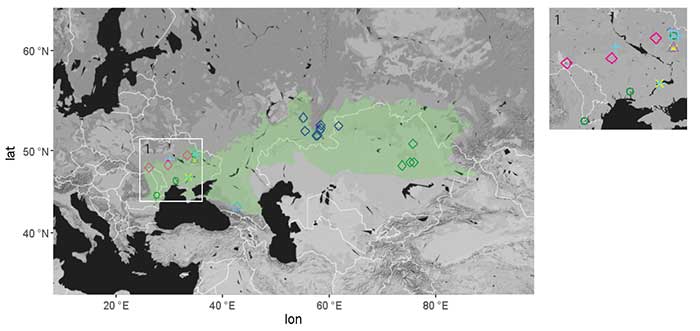
From the paper:
The Chernyakhiv culture was likely an ethnically heterogeneous mix based on Goths (Germanic tribes) but also including Sarmatians, Alans, Slavs, late Scythians and Dacians – the entire ancient population of the northern coast of the Black Sea.
Contacts with neighbouring regions were active, and the Chernyakhiv culture is associated with a number of historical events that took place in Europe at that time. In particular, during the Scythian or Gothic wars of the 230s and 270s, barbarians living in the territory of the Chernyakhiv culture (Goths, Ferules, Carps, Bastarns, etc.) carried out regular raids across the Danube Limes of the Roman Empire. However, from the end of the 3rd century the relations of the barbarians with the Roman Empire gained a certain stability. From the reign of Constantine I the Goths, who were part of the Chernyakhiv culture, became federates (military allies) of the Empire.
The Goths also interacted with the inhabitants of the East European forest zone. The Roman historian Jordanes described the military campaigns of the Gothic king Ermanaric against northern peoples (the ancestors of Vends, Slavs, etc., and the inhabitants of the northern Volga region).
NOTE. As it has become traditional in writings about eastern Europe, ‘Slavs’ are assumed – for no particular reason – to be part of the ‘northern peoples of the forest’ since who knows when exactly, and thus appear mentioned in this very text simultaneously as part of Chernyakhov, but also part of peoples to the north of Chernyakhov warring against them…

Genetic variation
(…) the Chernyakhiv samples overlapped with modern Europeans, representing the most ‘western’ range of variation among the groups of this study.
After the end of the Scythian period in the western Eurasian Steppe, the Chernyakhiv culture samples have higher Near Eastern affinity compared to the Scythians preceding them, agreeing with the Gothic component in the multi-ethnic mix of the Chernyakhiv culture.
The higher proportion Near Eastern and (according to CP/NNLS) lower proportion of eastern ancestry in the Chernyakhiv culture samples were mirrored by f4 analyses where Chern showed lower affinity to Han (Z score –3.097) and EHG (Z score –3.643) than Ukrainian Scythian and Bronze Age samples, respectively, as well as higher Near Eastern (Levant_N and Anatolia_N) affinity than Ukrainian Scythians (Z scores 4.696 and 3.933, respectively). It is plausible to assume that this excess Near Eastern ancestry in Chern is related to European populations whose Near Eastern proportion has exceeded that in the steppe populations since the Neolithic expansion of early farmers. While the Chernyakhiv culture was likely ethnically heterogeneous, the three samples in our Chern group appear to represent its Gothic component.
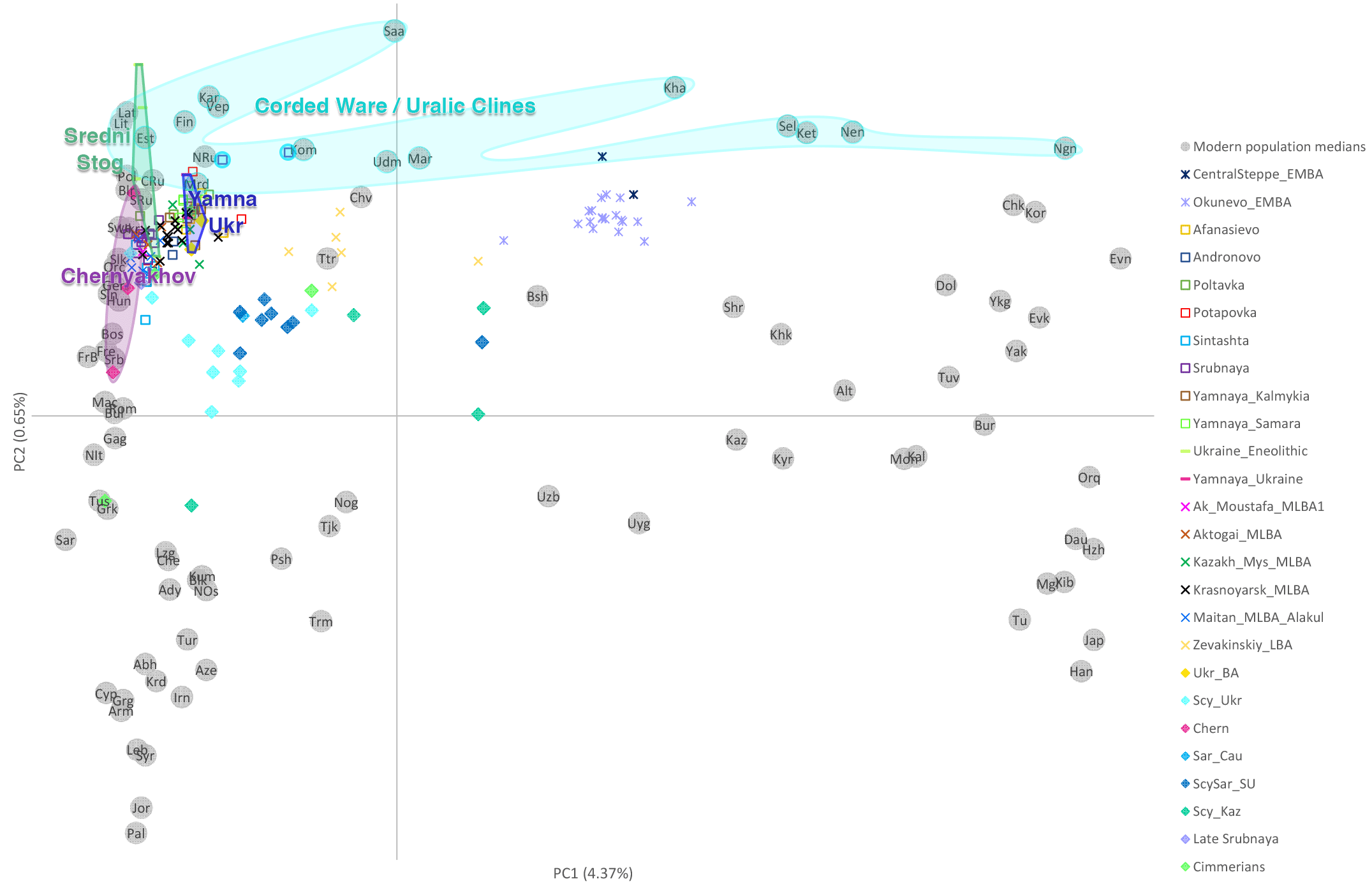
Early Slavs of hg. I2-L621
A post in Anthrogenica shows some subclades of the varied haplogroups that are expected from medieval Poland:
KO_55, Kowalewko (100-300 AD), I1a3a1a1-Y6626
KO_45, Kowalewko (100-300 AD), I2a2a1b2a-L801
KO_22, Kowalewko (100-300 AD), G2a2b-L30
KO_57, Kowalewko (100-300 AD), G2a2b-L30ME_7, Markowice (1000-1200 AD), I1a2a2a5-Y5384
NA_13, Niemcza, (900-1000 AD), I2a1b2-L621
NA_18, Niemcza, (900-1000 AD), J2a1a-L26
Just because of these samples among Early Slavs, and looking again more carefully at the modern distribution of I2a-L621 subclades, I think now I was wrong in assuming that I2a-L621 in early Hungarian Conquerors would mean they would appear around the Urals as a lineage integrated in Eastern Corded Ware groups. It seems rather a haplogroup with an origin in Central Europe. Whether it was part of a Baltic community that expanded south, or was incorporated during the expansions to the south is unclear. Like hg. E-V13, it doesn’t seem to have been incorporated precisely along the Danube, but closer to the north-east Carpathians.
Especially interesting is the finding of I2a-L621 among Early Slavs from Silesia, a zone of close interaction among early West Slavs. From Curta (2019):
On Common Slavs
In Poland, settlement discontinuity was postulated, to make room for the new, Prague culture introduced gradually from the southeast (from neighboring Ukraine). However, there is increasing evidence of 6th-century settlements in Lower Silesia (western Poland and the lands along the Middle Oder) that have nothing to do with the Prague culture. Nor is it clear how and when did the Prague culture spread over the entire territory of Poland.
On Great Moravia
Svatopluk’s remarkably strong position was immediately recognized by Pope John VIII, who ordered the immediate release of Methodius from his monastic prison in order to place him in 873 under Svatopluk’s protection. One year later (874), Louis the German himself was forced to recognize Svatopluk’s independence through the peace of Forchheim. By that time, the power of Svatopluk had extended into the upper Vistula Basin, over Bohemia, the lands between the Saale and the Elbe rivers, as well as the northern and northeastern parts of the Carpathian Basin.* The Czech prince Bořivoj, a member of the Přemyslid family which would unify and rule Bohemia in the following century, is believed to have been baptized in 874 by Methodius in Moravia together with his wife Ludmila (St. Wenceslas’s grandmother).
*Brather, Archäologie, p. 71. The expansion into the region of the Upper Vistula (Little Poland) results from one of St. Methodius’ prophecies, for which see the Life of Methodius 11, p. 72; Poleski, “Contacts between the Great Moravian empire and the tribes”; Poleski, “Contacts between the tribes in the basins.” Despite an early recognition of the Moravian influences on the material culture in 9th-century southern Poland and Silesia (e.g., Dostál, “Das Vordringen”), the question of Svatopluk’s expansion has triggered in the 1990s a fierce debate among Polish archaeologists. See Wachowski, “Problem”; Abłamowicz, “Górny Śląsk”; Wachowski, “Północny zasięg ekspansji”; Szydłowski, “Czy ślad”; Jaworski, “Elemente.”
On Piast Poland
Mieszko agreed to marry Oda, the daughter of the margrave of the North March, for his first wife had died in 977. The marriage signaled a change in the relations with the Empire, for Mieszko sent troops to help Otto II against the Slavic rebels of 983. He also attacked Bohemia and incorporated Silesia and Lesser Poland into the Piast realm, which prompted Bohemians to ally themselves with the Slavic rebels against whom Emperor Otto was now fighting. By 980, therefore, Mieszko was part of a broader configuration of power, and his political stature was recognized in Scandinavia as well. His daughter, Swietoslawa married first Erik Segersäll of Sweden (ca. 970–ca. 995) and then Sweyn Forkbeard of Denmark (986–1014).26 In the early 990s, together with his wife and children, Mieszko offered his state (called “civitas Schinesghe,” the state of Gniezno) to the pope as a fief, as attested by a unique document known as Dagome iudex and preserved in a late 11th-century summary. The document describes the inner boundaries of the state and peripheral provinces, as if Gniezno were a civitas (city) in Italy, with its surrounding territory. Regional centers, however, did indeed come into being shortly before AD 1000 in Lesser Poland (Cracow, Sandomierz), Pomerania (Gdańsk), and Silesia (Wrocław). Such regional centers came to be distinguished from other strongholds by virtue of the presence within their walls of some of the earliest churches built in stone. Mieszko got his own, probably missionary bishop.
In light of this recent find, which complements the Early Slav of the High Middle Ages from Sunghir (ca. AD 1100-1200), probably from the Vladimir-Suzdalian Rus’, we can assume now less speculatively that I2a-CTS10228 most likely expanded with Common Slavs, because alternative explanations for its emergence in the Carpathian Basin, among Early West Slavs, and among Early East Slavs within this short period of time requires too many unacceptable assumptions.
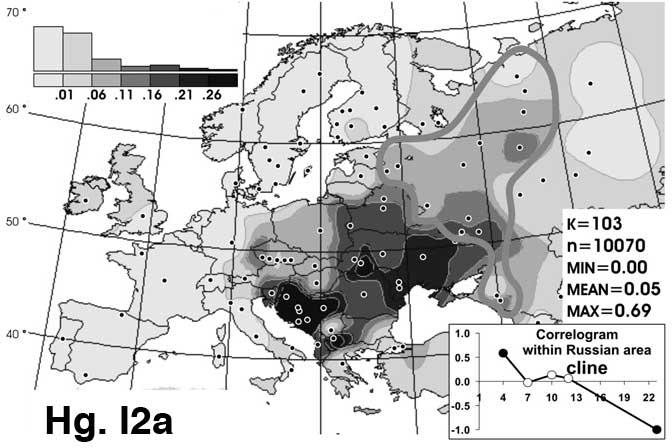
Hungarian Conquerors
Knowing that R1a-Z280 was an Eastern Corded Ware lineage, found from Baltic Finns to Finno-Ugric populations of the Trans-Urals, we can probably assign expanding Magyars to at least R1a-Z280, R1a-Z93, and N1c-L392 (xB197) lineages.
From Curta (2019):
Earlier Latin sources, especially those of the first half of the 10th century, refer to Magyars as Huns or Avars. They most likely called themselves Magyars, a word indicating that the language they spoke was not Turkic, but Finno-Ugrian, related to a number of languages spoken in Western Siberia and the southern Ural region. The modern word—Hungarian—derives from the Slavic word for those people, U(n)gri, which is another indication of Ugric roots. This has encouraged the search for the origin of the Hungarian people in the lands to the east from the Ural Mountains, in western Siberia, where the Hungarian language is believed to have emerged between 1000 and 500 BC.
In looking for the Magyar primordial homeland, they draw comparisons with the assemblages found in Hungary that have been dated to the 10th century and attributed to the Magyars. Some of those comparisons had extraordinary results. For example, the excavation of the burial mound cemetery recently discovered near Lake Uelgi, in the Cheliabinsk region of Russia, has produced rosette-shaped harness mounts and silver objects ornamented with palmette and floral designs arranged in reticulated patterns, which are very similar to those of Hungary. But Uelgi is not dated to prehistory, and many finds from that site coincided in time with those found in burial assemblages in Hungary. In other words, although there can be no doubt about the relations between Uelgi and the sites in Hungary attributed to the first generations of Magyars, those relations indicate a migration directly from the Trans-Ural lands, and not gradually, with several other stops in the forest-steppe and steppe zones of Eastern Europe. In the lands west of the Ural Mountains, the Magyars are now associated with the Kushnarenkovo (6th to 8th century) and Karaiakupovo (8th to 10th century) cultures, and with such burial sites as Sterlitamak (near Ufa, Bashkortostan) and Bol’shie Tigany (near Chistopol, Tatarstan).14 However, the same problem with chronology makes it difficult to draw the model of a migration from the lands along the Middle Volga. Many parallels for the so typically Magyar sabretache plates found in Hungary are from that region. They have traditionally been dated to the 9th century, but more recent studies point to the coincidence in time between specimens found in Eastern Europe and those from Hungary.
Adding J2a and I1a samples to the Early Slavic stock, based on medieval samples from Poland – with G2a and E-V13 lineages probably shared with Goths from Wielbark/Chernyakhov, or becoming acculturated in the Carpathian Basin – one is left to wonder which of these lineages actually took part in Common Slavic migrations/acculturation events, whenever and wherever those actually happened.
I have tentatively re-assigned lineages of Hungarian conquerors according to their likely origins in a simplistic way – similar to how the paper classifies them – , now (I think) less speculatively, assuming that Early Slavs likely formed eventually part of them:
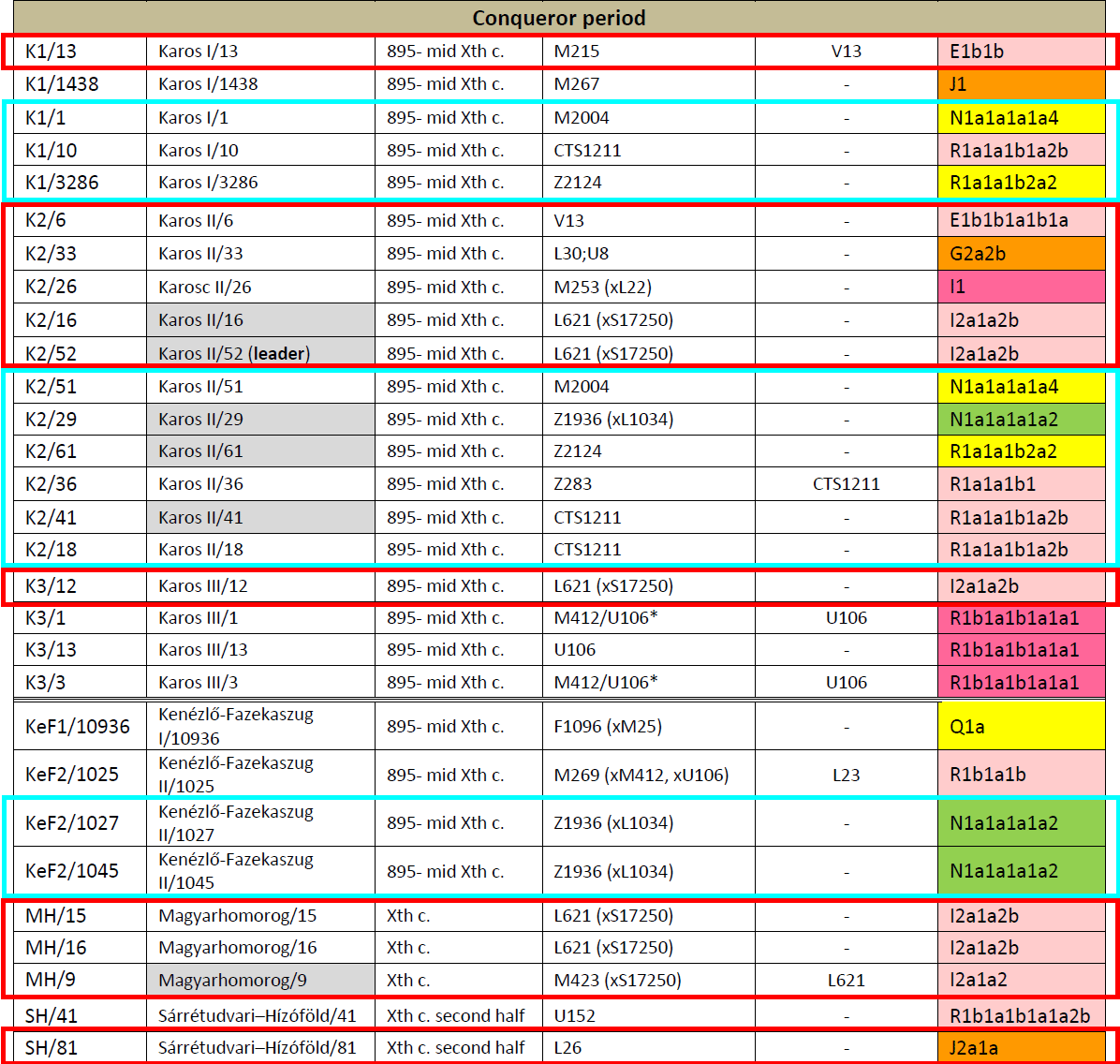
NOTE. The ancestral origin of lineages is meaningless for an ethnolinguistic identification. The only reasonable assumption is that all the individuals sampled formed part of the Magyar polity, shared Magyar culture, and likely spoke Hungarian, unless there is a clear reason to deny this: which I guess should include at least a clearly ‘foreign’ ancestry (showing a distant cluster compared to the group formed by all other samples), ‘foreign’ isotopic data (showing that he was born and/or raised outside of the Carpathian Basin), and particularly ‘foreign’ cultural assemblage of the burial, if one really wants to risk assuming that the individual didn’t speak Hungarian as his mother tongue.
“Dinaric” or Slavic I2a?
I don’t like the use of “Dinaric I2a”, because it is reminiscent of the use of “Iberian R1b-DF27”, or “Germanic R1b-U106”, when ancient DNA has shown that this terminology is most often wrong, and turns out to be misleading. As misleading as “Slavic R1a”. Recently, a Spanish reader wrote me emails wondering how could I possibly say that R1b-DF27 came from Central Europe, because modern distribution maps (see below) made it evident that the haplogroup expanded from Iberia…
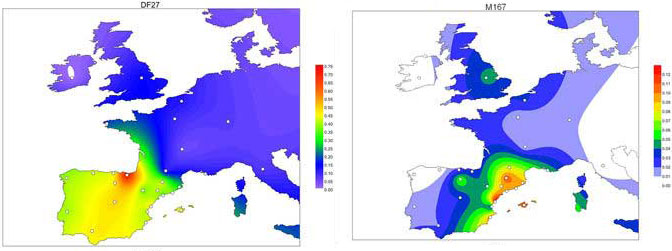
The obvious answer is, these maps show modern distributions, not ancient ones. In the case of R1b-DF27, different Iberian lineages are not even related to the same expansion. At least R1b-M167/SRY2627 lineages seem to have expanded from Central Europe into Iberia much more recently than other DF27 subclades associated with Bell Beakers. What’s more, if R1b-M167/SRY2627 appear densest in north-east Spain it is not because of the impact of Celts or Iberians before the arrival of Romans, but because of the impact of medieval expansions during the Reconquista from northern kingdoms expanding south in the Middle Ages:
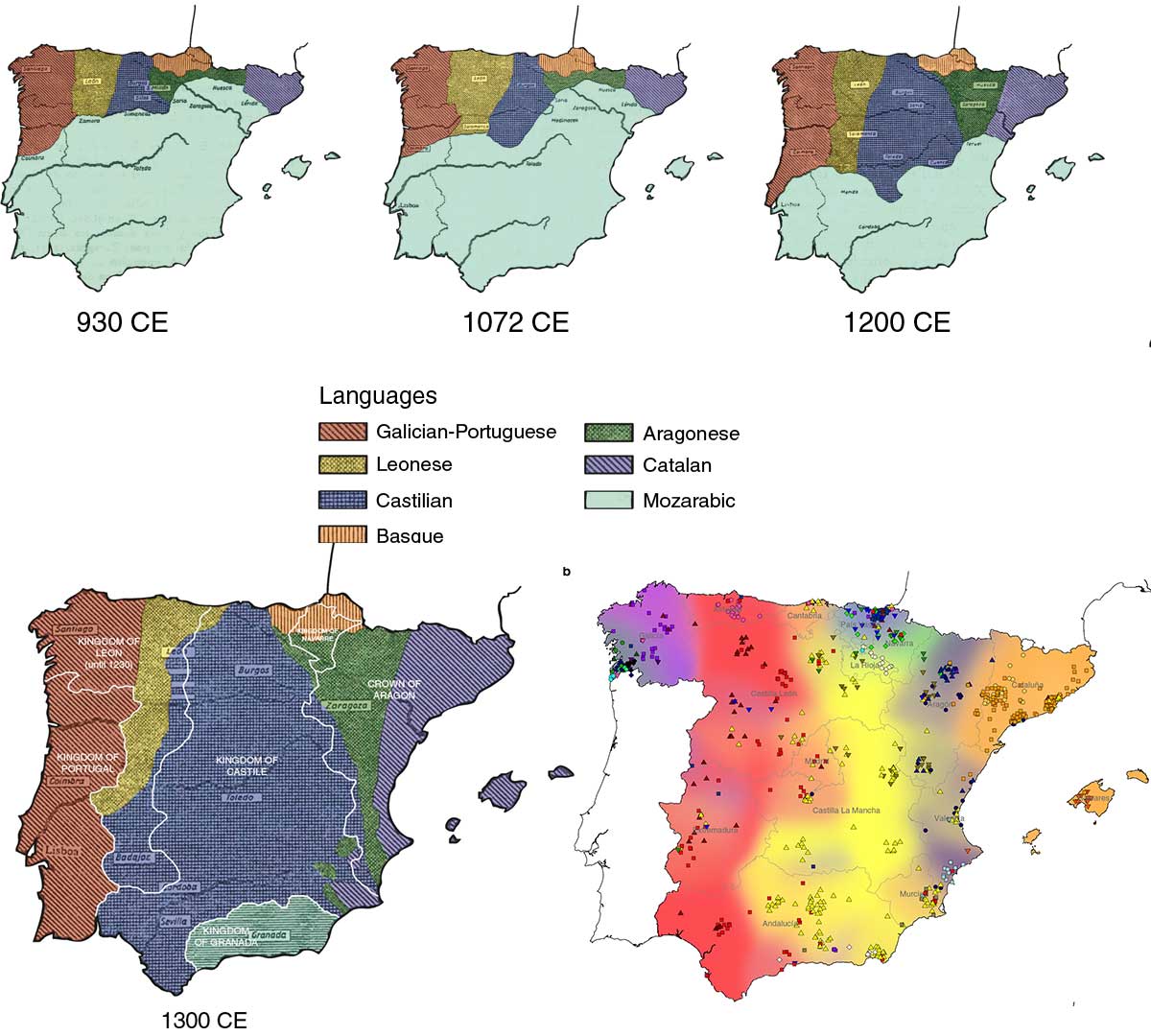
Similarly, the term “Dinaric I2a”, based on the higher density in the Western Balkans, is misleading because it is probably the result of later bottlenecks. Just like the density of different R1a subclades among Modern Slavs is most likely the result of acculturation of different groups, especially to the east and north-east, where language shift is known to have happened in historical times, with the cradle of Russians in particular being a Finno-Volgaic hotspot, later expanding with hg. R1a-Z280 and N1c-L392 lineages.
Now, one may think that maybe Slavs expanded with ALL of these different lineages. Since we are talking about late Iron Age / medieval expansions, there might be confederations of different peoples expanding with a single lingua franca… But no, not really. Not likely in linguistics, not likely in archaeology, and apparently not in population genomics, either.
How many ancient peoples from the Iron Age and Early Middle Ages expanded with so many different lineages? We see bottlenecks in expansions even in recent times: say, in Visigoths under E-V13 (probably recently incorporated during their migrations); in Moors (mostly Berbers) with E-M81 and J; in medieval Iberians under different DF27 bottlenecks during the Reconquista (including huge bottlenecks among Basques); similarly, huge bottlenecks are found in Finnic expansions under N1c…How likely is it that Proto-Slavs (and Common Slavs) expanded with all those attested lineages to date among Early Slavs (E-V13, I2a-L621, R1a-M458, I1, J2a) AND also with other R1a subclades prevalent today, but almost absent in sampled Early Slavs?
To sum up, I am not so sure anymore about the possibility of simplistically assigning R1a-M458 to expanding Common Slavs. R1a-M458 may well have been the prevalent R1a subclade in Central Europe among early Balto-Slavic – and possibly also neighbouring Northern Indo-European-speaking – peoples (let’s see what subclades Tollense and Unetice samples bring), but it is more and more likely that most of the density we see in modern R1a-M458 distribution maps is actually the effect of medieval bottlenecks of West Slavs, similar to the case of Iberia.
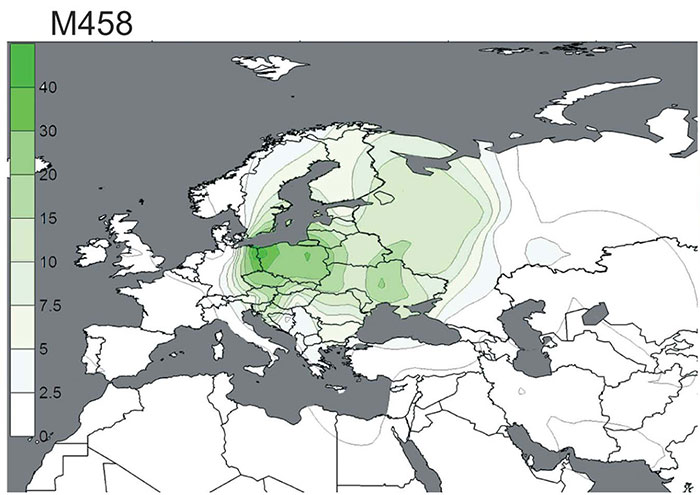
Related
- Common Slavs from the Lower Danube, expanding with haplogroup E1b-V13?
- Aquitanians and Iberians of haplogroup R1b are exactly like Indo-Iranians and Balto-Slavs of haplogroup R1a
- Magyar tribes brought R1a-Z645, I2a-L621, and N1a-L392(xB197) lineages to the Carpathian Basin
- R1a-Z280 and R1a-Z93 shared by ancient Finno-Ugric populations; N1c-Tat expanded with Micro-Altaic
- Scytho-Siberians of Aldy-Bel and Sagly, of haplogroup R1a-Z93, Q1b-L54, and N
- Mitogenomes from Avar nomadic elite show Inner Asian origin
- The complex origin of Samoyedic-speaking populations
- Corded Ware—Uralic (IV): Hg R1a and N in Finno-Ugric and Samoyedic expansions
- Corded Ware—Uralic (III): “Siberian ancestry” and Ugric-Samoyedic expansions
- Corded Ware—Uralic (II): Finno-Permic and the expansion of N-L392/Siberian ancestry
- The traditional multilingualism of Siberian populations
- Iron Age bottleneck of the Proto-Fennic population in Estonia
- Y-DNA haplogroups of Tuvinian tribes show little effect of the Mongol expansion
- Corded Ware—Uralic (I): Differences and similarities with Yamna
- Haplogroup R1a and CWC ancestry predominate in Fennic, Ugric, and Samoyedic groups